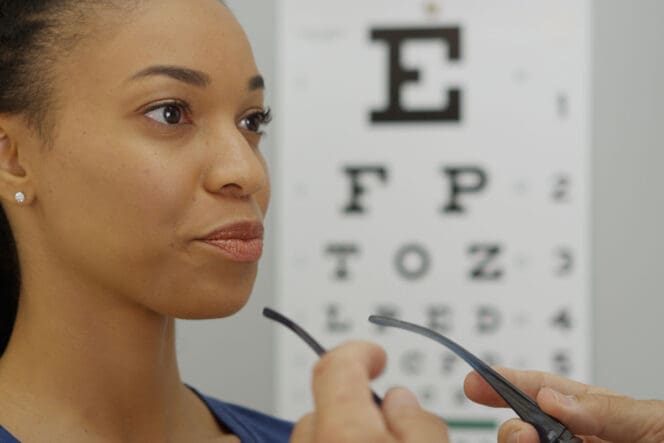Ophthalmoplegia: Causes, Risk Factors, Treatment & More
Internuclear ophthalmoplegia is an eye condition that affects the way the eyes coordinate together, causing double vision, difficulty tracking fast objects, and potentially dizziness.
Progressive external ophthalmoplegia is a more serious and rare genetic condition.
Ophthalmoplegia Symptoms
There are broadly two types of ophthalmoplegia, and both can occur on a spectrum in terms of severity.
One type is internuclear ophthalmoplegia (INO). With this condition, the eyes cannot always work in unison. It is characterized by an ipsilesional adduction deficit, where one eye lags to match the other and often has a reduced range of movement.
Symptoms of internuclear ophthalmoplegia can include the following:
- Double vision
- Difficulty tracking fast objects
- Dizziness
Progressive external ophthalmoplegia is superficially similar. This condition affects muscles related to the eye. Symptoms can include the following:
- Droopy eyelids
- Difficulty moving the eyes
- Muscle weakness in other areas, including the neck, arms, legs, and throat
The following symptoms are less common with progressive external ophthalmoplegia:
- Hearing loss
- Limb numbness
- Impaired muscle coordination
- Parkinsonism (movement abnormalities often associated with Parkinson’s disease)
- Depression
As a progressive condition, progressive external ophthalmoplegia worsens over time, usually becoming noticeable between the ages of 18 and 40.
Progressive external ophthalmoplegia is a rare genetic condition. It is a serious condition, and more research into its causes and how to help those affected is needed.

Causes of Internuclear Ophthalmoplegia
Internuclear ophthalmoplegia is caused by damage to the interneuron between two specific nuclei of cranial nerves. This can happen as a result of lesions developing in the medial longitudinal fasciculus (MLF), which generally occurs due to multiple sclerosis in young people or stroke in older people.
Less typically, other causes can include the following:
- Brain tumor
- Lyme disease
- Head trauma
- Nutritional disorders
- Drug use
- Neurosyphilis
- Arnold-Chiari malformation (an uncommon skull deformity)
Risk Factors
About 70 percent of patients experience this condition as a result of either multiple sclerosis or cerebrovascular accidents, namely stroke.
Risk factors for multiple sclerosis include the following:
- Being between 20 and 50 years old
- Being a cisgender woman, possibly due to hormonal differences
- Being Caucasian of northern European ancestry, with some evidence also suggesting a comparable risk for African American women
Risk factors for cerebrovascular accidents include the following:
- Being elderly (70+ years old)
- Hypertension
- Diabetes
- Smoking
Keep in mind that both these conditions can affect people outside their primary risk groups. You also aren’t necessarily going to develop ophthalmoplegia just because you develop one of the above conditions.
Diagnosis
Doctors can diagnose ophthalmoplegia with a straightforward eye exam, primarily by tracking your eye movements.
Treatments for Ophthalmoplegia
The best way to treat ophthalmoplegia will depend on its cause.
The most common treatment for internuclear ophthalmoplegia is the use of botulinum toxin injections or Fresnel prisms to help tighten the affected muscles.
Your doctor may also decide a surgical correction is a good option for you, depending on the specifics of your condition.
Prevention
This condition is rare enough that active prevention efforts likely aren’t necessary for most people. However, maintaining a healthy, safe lifestyle can notably reduce your risk of ophthalmoplegia and other conditions simultaneously.
Eating a good diet, avoiding smoking or quitting if you already smoke, and making sure to monitor yourself closely if you have diabetes can all help reduce your risk of vascular health issues.
Protecting your brain by wearing the appropriate protective gear and avoiding unnecessary risks can further help to reduce your risk of trauma, which is best avoided for many reasons.
Outlook for Ophthalmoplegia
Your outlook when recovering from ophthalmoplegia depends on its cause. For example, people who have developed ophthalmoplegia as a result of trauma often don’t recover.
Luckily, most patients who experience internuclear ophthalmoplegia have a fairly good prognosis and will improve over time.
In a small series of 65 INO patients, about 50 percent of patients who experienced internuclear ophthalmoplegia saw full or nearly full recovery after about a year of treatment. Many patients recover faster than that.
Ophthalmoplegia FAQs
How is ophthalmoplegia treated?
First, a doctor needs to determine the cause of your ophthalmoplegia. The treatment is then guided by this underlying cause. They may use botulinum toxin injections, Fresnel prisms, surgical correction, or another option, depending on the circumstances.
Can ophthalmoplegia be cured?
Not all cases of ophthalmoplegia can be fully cured with modern medicine. If your ophthalmoplegia is caused by a genetic disorder, brainstem demyelination, or trauma, your doctor can likely still help, but you may not be able to restore your eyes to the functionality they had before you developed your condition.
With that said, other cases of ophthalmoplegia can see a full or near-full recovery. This is why it is important to talk to your doctor about realistic expectations, as your specific prognosis can vary quite a bit.
References
-
Internuclear Ophthalmoplegia. (April 2022). American Academy of Ophthalmology.
-
Internuclear Ophthalmoplegia. (February 2022). MSD Manual.
-
Internuclear Ophthalmoplegia. (June 2021). StatPearl.
-
Progressive External Ophthalmoplegia. (May 2016). MedlinePlus.
-
Who Gets MS? (Epidemiology). National Multiple Sclerosis Society.
-
Progressive External Ophthalmoplegia. (April 2016). Neuro-Ophthalmology.
-
The Non-Surgical Management of Ophthalmoplegia. (January 2018). Journal of Binocular Vision & Ocular Motility.
-
Ophthalmoplegia: When the Eyes Don’t Move: An Introduction. (February 2018). Journal of Binocular Vision & Ocular Motility.
-
Internuclear Ophthalmoplegia: Causes and Long-Term Follow-Up in 65 Patients. (September 2004). Acta Neurologica Scandinavica.
Last Updated June 8, 2022
Note: This page should not serve as a substitute for professional medical advice from a doctor or specialist. Please review our about page for more information.